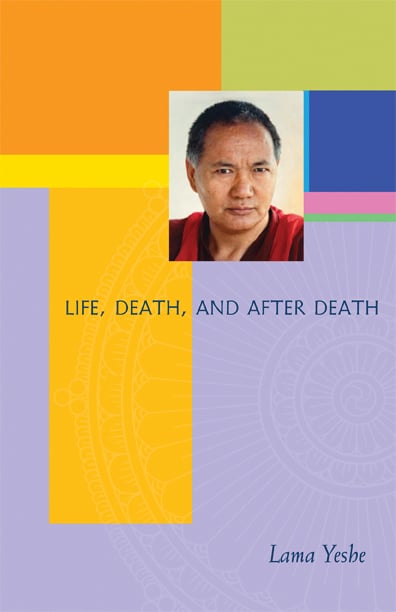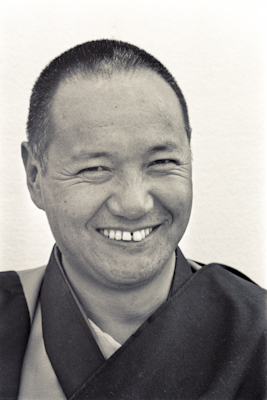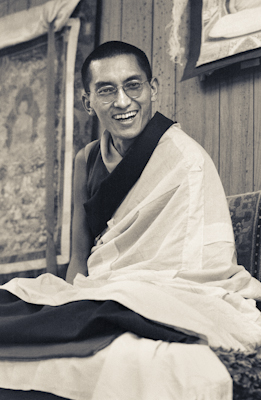Dear LYWA friends and supporters,
Thank you so much for your interest in and support of the Lama Yeshe Wisdom Archive, which brings you and the world the teachings of Lama Yeshe, Lama Zopa Rinpoche and many other great lamas, including His Holiness the Dalai Lama.
Year-End Appeal
As you know we’re in the last throes of our 2010 year-end appeal. This is, of course, the last chance for our supporters in the USA to make a tax-deductible donation. Our goal is $50,000 and we’re nearly 2/3 of the way there.
So I would like to thank most sincerely all those who have contributed so far. And exhort those who have not yet done so to please help us maintain and develop our archive of precious teachings so that we can bring free teachings to a world that really needs them, via our website and the free books we publish, of which there are now nearly 600,000 in print.
Thank you so much. We need $20,000 more to reach our goal. Please help.
Life, Death and After Death Our next free book, Lama Yeshe's Life, Death and After Death, is now with the printer and we expect to have copies to ship in early January. The book contains the teachings Lama Yeshe gave at a weekend seminar on death and dying in Geneva, September 1983—the last teachings he gave in the West—a general discourse given by Lama Zopa Rinpoche at the seminar, and a short teaching Lama Yeshe gave on transference of consciousness in London the previous year.
Our next free book, Lama Yeshe's Life, Death and After Death, is now with the printer and we expect to have copies to ship in early January. The book contains the teachings Lama Yeshe gave at a weekend seminar on death and dying in Geneva, September 1983—the last teachings he gave in the West—a general discourse given by Lama Zopa Rinpoche at the seminar, and a short teaching Lama Yeshe gave on transference of consciousness in London the previous year.
As usual, when we receive Life, Death and After Death we will automatically send it to all our Members and Benefactors. If you’re neither a member nor a benefactor, now could be just the right time to become one. Make your donation and you'll not only be supporting our year-end appeal but you'll be shipped a copy of Lama Yeshe's new book as soon as it arrives.
Singapore and Malaysia
In February I will be in Singapore for Lama Zopa Rinpoche’s teachings at Amitabha Buddhist Centre. After that I’ll be in KL and Penang for a few days. I met many LYWA friends and supporters there last year and look forward to catching up with you again and meeting new friends. Please email me if you would like to meet up. Thank you so much.
 Online Image Gallery Feature: Images from 1975
Online Image Gallery Feature: Images from 1975
Our latest album of images from 1975 includes:
• Pictures of a young Yangsi Rinpoche;
• Ordination with His Holiness the Dalai Lama;
• A visit to Chenrezig Institute;
...and much more.
There are other albums from 1975 as well featuring images of Lama Yeshe and Lama Zopa Rinpoche teaching at Lake Arrowhead, and a series of portraits of Rinpoche. Check them out!
New on the Web
Lama Zopa Rinpoche's Online Advice book continues to grow. We have nearly 1000 advices posted! This month's new additions include General Practice advices, advice for lamrim and meditation practices for prisoners, and a daily practice advice which we've included below as this month's e-letter teaching.
We have also posted the entire transcript of Lama Zopa Rinpoche's teachings at the 25th Kopan annual meditation course in 1992. You can read it online or download the entire course in a pdf file. We have also posted two edited excerpts from the course, Searching for the I and Universal Responsibility.
Thank you again for your kindness and generosity. Please help LYWA’s 2011 be our best year yet!
Much love,
Nick Ribush
Director
Daily Practice Advice From Lama Zopa Rinpoche
 Rinpoche composed the following letter to an ex-monk who had written to him many times. One of the problems he was experiencing was receiving criticism and abuse from people, and he also felt that some women were pursuing him. He had studied a good deal. (Note that the name has been changed.)
Rinpoche composed the following letter to an ex-monk who had written to him many times. One of the problems he was experiencing was receiving criticism and abuse from people, and he also felt that some women were pursuing him. He had studied a good deal. (Note that the name has been changed.)
My dearest Michael,
Thank you very much for all your wonderful letters, past and present. I could have put them together like the Kangyur, hundreds of Buddha’s texts, but the thought didn't come to me before. They could have been written out in gold and silver and put in the highest place.
I still remember and enjoy your company and your good knowledge of English. I wish you knew Tibetan like that. Then you could teach it to the people in America.
Every day, in the morning, when you begin the day, please remember emptiness. Everything is empty: I, action, and object. You can recite the Heart Sutra and the quotations below.
If you can, remember them in your daily life again and again. When you open the door, when the day begins, while seeing the reality of phenomena or the reality of life, recite and meditate on the meaning of these words.
These are Buddha's words from the Sutra of the King of Concentration:
As in the clear sky, the moon rises,
the reflection appears in the ocean,
but there is no transfer of the moon into the water:
All phenomena should be known to be of that nature.The magician transforms the forms
Of various phenomena, like a horse carriage and an elephant,
but there is nothing there as it appears:
All phenomena should be known to be like that.Exactly as when following sexual pleasure in a dream,
after the person wakes up, they cannot see it,
like an immature person who is extremely attached to sexual pleasures:
All phenomena should be known like that.Exactly as in the dream of a young girl
Of giving birth to a son who died,
so happy to have given birth, but unhappy that he died:
All phenomena should be known like that.Exactly like the nighttime moon
that appears in the water, calm and clear,
but the moon on the water is empty, you cannot catch it:
All phenomena should be known like that.Exactly as at noon in autumn,
people tormented with thirst
see a mirage as water:
All phenomena should be known like this.A mirage has no water.
Sentient beings are dying of thirst and desire to drink
but are unable to drink that water, which does not exist:
All phenomena should be known like that.Exactly like the water tree:
even if a person wishes to take the essence from it,
a person splits that tree, there is no essence at all, no nectar inside or outside:
All phenomena should be known like that.
Also, it is good if you can recite the verses in the Thirty-Seven Practices of the Bodhisattva on emptiness, by the bodhisattva Thongme Sangpo.
Various sufferings appear in hallucinations, like a son who dies in a dream:
by holding it to be true, one suffers.
Therefore, when you encounter disharmonious conditions (that is, conditions not according to your wish, unfavorable conditions)
Looking at them as an illusion is the practice of the son of the bodhisattvas.
You are a very philosophical person. I am sure I don't need to explain this to you. I am sure your mind is always this way, but I will explain it anyway.
The way to meditate on the first stanza is this: The meaning is that ignorance leaves imprints, that are impure, on the mental continuum. Like the moon reflecting on the ocean, those imprints project hallucinated appearances, truly existent appearances. They project all the hallucinations that appear, appearing as truly existent, on the merely labeled phenomena—I, action, object, happiness, suffering, virtue, non-virtue—whatever exists.
Including the mind as well as its object—the perceiver/knower, or mind, and its object—these look or appear like they are there, but they are not there. A truly existent real knower or perceiver, the mind and object, look like they are there, but they are not there.
In reality, everything is empty. Therefore, in reality all that is appearing as real is appearances, but is totally non-existent, empty.
All that appears to be real, inherently existent, in our daily life, this inherently existent phenomenon or real phenomenon, is totally non-existent. The way phenomena appear should be understood as non-existent, totally non-existent.
Therefore, all phenomena—I, action, object—all the phenomena that exist, are empty. They are empty from their own side. They are empty from their own side because all these phenomena exist by being merely labeled.
For the rest of the stanzas, you can get the basic idea from this explanation. Then all day you can laugh about your own life, your own beliefs, own fears, and grasping. You can laugh even when you are alone in your room. You can laugh 24 hours a day about your own life. You can laugh in the kitchen making tea. You can laugh in the shop. You can laugh in your bedroom, when you’re sleep, everywhere. You can laugh when you feel depressed. You can laugh when you feel excited.
The second part is thought transformation, how to meditate on emptiness during the meditation break and to look at all phenomena during break times like a dream. That means looking at the object of the knower as empty—not true: empty. Examining the nature of unborn wisdom—that is wisdom meditating on the emptiness of that—free even of the remedy itself.
Even the remedy, even emptiness itself, has no inherent existence, it is free of that. Look at emptiness itself as empty of inherent existence. This could also be related to the self, the person, the meditator, to oneself, as also empty.
Place the mind in the state of the base, which is the essence of the path. In the break time, be the illusory person.
This is what you should apply when you think that women are pursuing you. You should use these things to practice Dharma, to meditate on emptiness, and to achieve realizations on emptiness. That means you are using this situation of harm and negativity to achieve liberation from samsara for yourself, and to achieve enlightenment for all sentient beings. Why? Because realizing emptiness is the only thing that can directly cut through the two defilements, gross and subtle.
The next thing is you should apply all these conditions to develop bodhicitta.
There are multiple sentient beings that are suffering, with so many problems. Think: “I will take all those sufferings on myself, as well as their causes.” Practice the visualization from time to time during the day. Every time the thought of problems comes, think, “I am experiencing these problems, this harm, on behalf of all sentient beings, to lead them to all happiness up to enlightenment.”
This way you are using unfavorable situations—sicknesses, harm, being criticized, being put down, even death—to achieve enlightenment. You are using these unfavorable situations, sickness, people trying to harm you, whatever you believe is happening, including death, to liberate countless sentient beings from the oceans of samsaric sufferings and to bring them to enlightenment. You are also using unfavorable situations to purify so much negative karma and collect vast amounts of merit.
Listening to teachings on emptiness collects more merit than listening to teachings on the other five paramitas (charity, morality, so forth) for ten eons. Explaining teachings on emptiness collects far greater merit than teaching the other five paramitas for ten eons. Meditating on emptiness for one second collects more merit than explaining teachings on emptiness for ten eons.
So, however much merit you collect, there is also an incredible amount of purification. There is no question about bodhicitta. The infinite merit you collect can be unbelievably powerful purification, as you know from the benefits of bodhicitta in the lamrim and in The Bodhisattva’s Way of Life (Shantideva), in the first chapter.
So, make your life the best through unfavorable situations. This is the best protection and most useful.
Take care of your life with these two practices: meditating on emptiness and bodhicitta. These are the fundamentals of tantra.
With much love and prayer,
Lama Zopa Rinpoche
Edited by Michelle Bernard. For more practice advice of all kinds see Lama Zopa Rinpoche's Online Advice Book.































